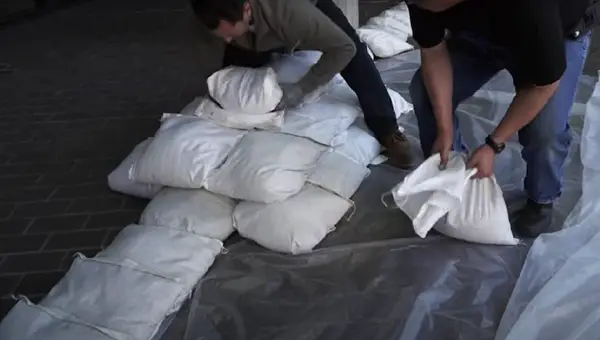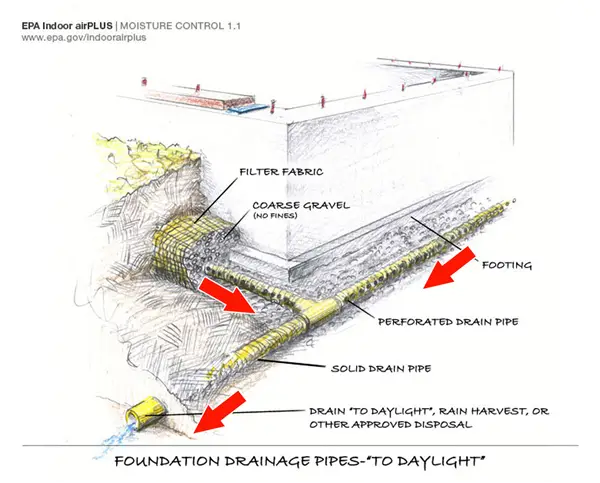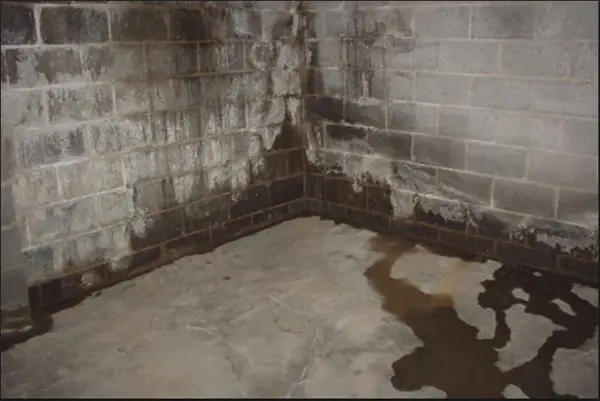My basement is not wet and therefore I don’t need a sump pump to keep it dry. All my neighbors however have a sump pump in their basements. In this article, I’ll explain why. Depending on where in America you live, I will also answer the question: “Do I need a sump pump?”
Virtually all houses in far northern America have a basement. That’s because house footings must be dug at least 4’ deep to prevent frost from lifting the house. It is therefore economical to add a full basement when a house is being built.
If a house has a basement, it is usually best to have a sump pump.
Homes in southern Florida have a concrete floating slab because of the high-water table in addition to the warm weather. Whereas, crawl spaces become more common as you head north.
Homes built on concrete slabs are usually placed on a bed of gravel to raise the house above the surrounding earth elevations. In this case an external sump pump is sometimes needed because of occasional local flooding.
In many states, for example, heavy rains cause local flooding. In these scenarios, a sump pump system and outdoor French drain may save the house from being ruined by water.
- 1/3 HP Sump pump moves up to 2,760 gallons per hour; pump will lift water up to 25′ of vertical height
- Rugged cast iron construction; 10-foot cord length
- Vertical float switch to automatically turn the pump on/off. Switch on and off point is 6 and 2 inches
- 1-1/2 inch NPT discharge for high capacity pumping
- Superior Pumps are Built to Last, engineered with quality components and are 100% factory tested
Table of Contents
Have You Ever Had to Put Sandbags Around Your House?
If you have ever had to place sandbags around your house to prevent it from becoming flooded, you need a sump pump. It may be that a temporary sump pump placed between the house and the sandbags is sufficient to pump away any water that makes it past the sandbags.
If the sandbags are enough to stop the flood waters from reaching your house, you will still have to pump the rainwater that runs off your exterior walls and roof.

Do I need A Sump Pump in The State Where I Live?
You may need a sump pump, or you may not.
I browsed the Wisconsin new construction code (SPS 321.17 Drain tiles.) about sump pumps. Sump pumps were required where groundwater occurs above the bottom of the footing. Municipal authorities may allow or require partial drain tile systems with sump pumps in existing homes.
Your state might be different. Local city codes can be more restrictive than State codes. So, be sure to check at City Hall.
Do I Need a Sump Pump in My Basement?
To make sure if you need a sump pump, check with the code authorities in your local area. This may be a county government, township, or city authority. When new regulations are adopted, homes are often grandfathered in.
Where I live however, any new plumbing and remodeling must be done according to current codes. It is likely the same is true for where you live.
Do You Have a Musty Smell in Your Crawl Space or Basement?
This problem is very common in basements and crawl spaces in Wisconsin. There are numerous reasons why water can seep through concrete floors and walls. This leads to the damp concrete leaving a musty smell.
Although a dehumidifier will remove excess moisture from the air, it can’t handle flowing water. It will also not solve the problem of damp walls or floors.
When the interior walls are sealed to prevent water from seeping through, it may well force the water up through the floor.
A typical solution for this problem is to install a sump pump and drain tile. Although this is extremely effective, it does not protect your home totally.
The complete solution would be to install an exterior drain tile system and seal the exterior foundation wall permanently. The water that gathers in the drain tile is then pumped away by an interior sump pump.

Roller painting a basement wall with regular paint will not stop a leaking wall. Waterproofing paint will force the water to collect at the bottom of the wall and will seep out through the floor.
Do I Need a Sump Pump in My Crawl Space?
Years ago, when I was house hunting, I looked at a house that was on the edge of a state wildlife preserve. There was a wetlands area at the edge of the property. In the middle of a hot dry summer the sump pump was running constantly. For very wet locations consider getting a 3/4 HP sump pump to handle large volumes of water. For example the Wayne 58321-WYN3 CDU980E shown below.
- INDOOR USE ONLY – This 3/4 HP WAYNE basement sump pump is perfect to keep your basement dry during heavy water flow. Whether it’s rain, snow melting, etc. WAYNE model CDU980E can pump up to 5,490 GPH to keep your basement dry.
- TOUGH AND DURABLE – Corrosion-resistant stainless steel motor housing and fasteners come with a cast-iron volute that provides long life in tough sump pump applications.
- EFFICIENT DESIGN – The top suction design eliminates air lock and minimizes clogging from any debris in the bottom of the sump pit. Easy to install in about 15 minutes with no need to drill a weep hole!
- ADDITIONAL FEATURES – 1-1/2” NPT discharge for compliance with building codes. The vertical float switch has been tested to 1 million cycles for long-lasting use.
- QUALITY YOU DESERVE – Proudly assembled in the USA for quality you can trust. Warrantied for 5 years for dependable, efficient, & ultra-quiet performance.
At some stage, I owned a house that was close to a lake. One would expect to have a high-water table that needed a sump pump to be used when living close to a lake. That house however had a partial crawlspace and a partial basement, and there was never any sign of water under the house although it was near the lake.
This house was built before local building codes existed in the early 1920s. New construction in the area would likely now require sump pumps.
Is There Dry Rot or Mold in The Crawl Space?
Mold and dry rot are sure indications that you have a moisture problem, and the cure may include installing a sump pump. The required solution depends on how much water is involved.
It is often enough to seal the bare soil with a plastic sheet to protect your crawl space from the damp ground. If you do have running water, however, you will likely need a sump pump and drain tile.
The Floor of My Basement Is Damp. Do I need A Sump Pump?
Damp basement floors and walls can be caused by several reasons:
- Water enters hollow concrete blocks and then seeps out at floor level.
- Poured concrete walls oftentimes leak where the metal form ties protrude out of the concrete.
- Water is forced through the basement floor due to the water table rising.
- Rainwater flows down the foundation’s exterior and then under the floor. Where water can force itself through the floor.
Irrespective of the reason, you do need a sump pump.

Do I Need A Sump Pump If I Live On A Hill?
My neighbors need a sump pump but I don’t. I do not have a sump pump. My basement has been completely dry for many years.
You may ask: “Do I need a sump pump if I live on a hill?” This section will answer that question.
I live in an area that is very hilly. My house is on the highest elevation in the block, which puts me around 2’ to 3’ higher than my neighbors. The houses on the block’s east side are lower than the houses on the west side. This results in all of the surface rainwater flowing downhill to the east.
As some of the rainwater will also soak into the ground, it will also flow to the east, but underground. All the houses on that side have sump pumps that have to run often during spring rains and the snow melting in spring.
Why My House Doesn’t Require a Basement Sump Pump
As my house is at a higher elevation than those of the neighbors, the water flows away from my foundation. Half of my lot is also mostly gravel and sand, it drains water away very quickly.
When I built the house, I installed an all-wood foundation basement. The foundation has a thick plastic sheet wrapped around it and the wood was pressure treated to prevent rot.
A two-foot-wide band of washed gravel was poured outside the plastic sheet and the gravel runs all the way down and continues under the footings.
There is also 8” of washed gravel under the house. That volume of loose rock can hold a lot of water while it percolates into the soil below. That effectively acts like a huge dry well.
I also wanted to make sure that no water would push up through the concrete floor of the basement. To do this, a roof gutter that drains onto the driveway was fitted to the front of the house.
Although there is no gutter on the back roof, I placed a plastic sheet over the washed gravel and installed drain tile which is covered by black soil.
The drain tile takes all the water running from the roof and drains it into a shallow swale which serves as a rain garden. If the swale overflows, the runoff flows into the street.
Related articles:
Zoeller M53 Sump Pump Review. Best Value, Clog Free, Reliable
Zoeller M84 Pedestal Sump Pump Review (Zoeller 84-0001)
Zoeller M98 Sump Pump Review 1/2 HP Effluent and Dewatering

Author at Best Sump Pumps
The first time I helped to install a drain tile and basement sump pump system was 1978.
Since then I have worked for a city water utility where I worked with and maintained pumps.
My rental properties and personal homes all needed sump pumps.
As a modular home dealer/builder, those new homes needed sump pumps.
I put that experience to good use by providing reliable, useful, and practical advice on buying, using, and maintaining sump pumps.



